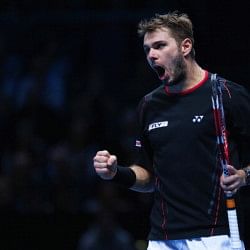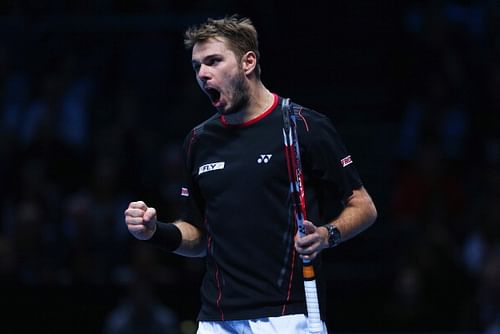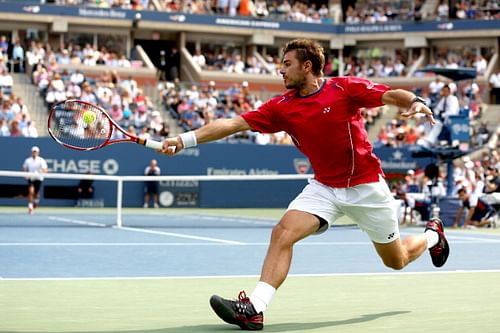
Stanislas Wawrinka - blossoming in the fall

Stanislas Wawrinka
Like the night heron, Stanislas Wawrinka has grown in the shade and gotten used to it. His fans needed the patience of a gardener tending to his camellias, for he has taken ever so long to bloom. The Swiss star has long been habituated to living in the reflected glory of his more illustrious compatriot, Roger Federer. It was as if Wawrinka’s script was written merely as a subplot to the story of Federer’s unsurpassed greatness. And the 28-year-old from Lausanne, it seemed, had reconciled himself to a home in the giant shadow of his countryman.
But then perseverance rarely, if ever, fails to reward its patient practitioner. Even though he had broken into the top 30 in 2006, he has since wallowed up and down the rankings without ever threatening to seal a place among the high priests of tennis. And then all of a sudden, he emerged with a hitherto-unseen gust of purpose. Just as the lights started to flicker for the flamboyant Federer, Wawrinka finally emerged from the shadows this season to lay a marker of his own.
Perhaps the beginning of Federer’s decline allowed Wawrinka to break the shackles that have held him prisoner for a long time. The first sign of Wawrinka’s renewed confidence found prosaic expression at the Australian Open. After an early exit from Chennai, Wawrinka surprised the tennis community with a determined performance against the man of the moment. The fourth round match at Melbourne against Novak Djokovic, an epic that lasted over five hours, served to introduce Wawrinka in a new light.
Wearing a coat of confidence, Wawrinka controlled the flow of play with superior strategy and strokes. At 5-2 in the second set, the Swiss had the match under his control, but the Serbian clawed his way back into the contest. In the past, Wawrinka would have been rattled by the resurgence of his fancied opponent and faded through the rest of the match. Wawrinka though showed great heart throughout the contest, before eventually succumbing 1-6, 7-5, 6-4, 6-7 (5), 12-10.
Even though the loss may have stung his soul, Wawrinka emerged confident and resolute from the painful defeat. Most importantly, he was no longer content with just playing a good match. And he knew too that he could hang with the best in the business and mix it up on his terms. The tide helped Wawrinka string together a series of good results that culminated in a hat-trick of top ten victories over David Ferrer, Jo-Wilfried Tsonga and Tomas Berdych, earning him an ATP 250 title in Portugal and a run to the finals of the ATP 1000 event in Madrid.
The admission from Djokovic that their fourth round in Melbourne was played off Wawrinka’s racket was probably the biggest indication of change for Wawrinka. The Swiss, despite possessing a solid forehand and a beautiful backhand, was guilty for being passive in his approach. Stuck way behind the baseline, he wafted from brilliant to painful struggling to find the consistency needed to push the elite players. but this year saw a few noticeable changes in Wawrinka’s approach on the court.
The world No. 8 was willing to believe in his abilities – working to put pressure on the second serve of his opponents and backing it up with a solid game from the baseline off both flanks. Perhaps that match against Djokovic gave Wawrinka much-needed confidence and his entire game feasted on it to finally blossom as it was meant to be. As he went about racking up victories, it was obvious that the Swiss No. 2 was finally going to be his own man.
And the results came irrespective of the surface they were playing on. It took Nadal to upend his confident run at the French Open, where the Spaniard ousted him in the quarter-finals. But just when he seemed poised for a good run on grass, reaching the finals at s-Hertogenbosch, a rough draw ended up pitting him against an equally determined Lleyton Hewitt. The Aussie played an inspired game of tennis to oust the in-form Wawrinka, but the first round exit did nothing to dent the Swiss man’s confidence.
As the hard court season gathered steam, it was getting increasingly obvious that Wawrinka would make the grade for the ATP World Tour finals in London. Despite possessing a solid collection of tools, the genial Swiss had never made the trip to the finale. – surprisingly, this was going to be his first ticket to the grand finale. The most compelling evidence of Wawrinka’s evolution came at the US Open.
Wawrinka saw off Berdych to earn his second Grand Slam quarterfinals berth this year and many wondered if he could really pose a threat to the freshly minted Wimbledon champion, Andy Murray. But Wawrinka produced the best performance of the season to trounce Murray in straight sets, without so much as facing a break point. And then he was part of another marathon against the man he was chasing all season – Djokovic. Yet again he was at the losing end of a gripping five-hour battle, but he did win the hearts of the fans that filled up the Arthur Ashe stadium in New York.

Stanislas Wawrinka
At the Tour Finals, the manner in which Wawrinka held his own in the company of the best players in the world was a statement in itself. A tough loss to Nadal was sandwiched between a couple of remarkably resilient performances against Berdych and Ferrer to propel himself into the semifinals of the the tournament. In both those matches, Wawrinka had to fight off his higher ranked opponents after losing the first set, and Nadal needed a pair of tie-breakers to get past the Swiss player.
Ironically, the season ended just as it had begun. Another loss to Djokovic ended his year, this time a relatively straightforward match that lasted only two sets. At the end of it all Wawrinka had a career-best 51-23 record and nearly $3 million to show for his sustained efforts through the season.
But the work has just begun for Wawrinka and his coach Magnus Norman. They will need to find a way to script victories over the men at the very top – Nadal and Djokovic – to find a way for Wawrinka to scale higher.
There are other men who have scaled more steps on the rankings ladder, but it is hard to argue against the case for Wawrinka as the most improved player this season. After all, none of the others had to contend with players of the quality that Wawrinka had to contend with all season. Norman and his ward will sure hope that the Swiss can keep it all together and mount another assault on the tight-knit club that has ruled tennis for the past decade.